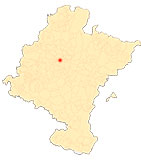pathway Teresian in Pamplona
The first foundation: the Discalced Carmelites of St. Joseph
Founded: 8 December 1583, by Mother Catalina de Cristo, a disciple of Saint Teresa. This was the first establishment of the Teresian Carmel in Navarre, one year after the death of Saint Teresa, who was involved in its preparations. Father Jerónimo de la Madre de Dios, the sisters Leonor de la Misericordia and Catalina del Espíritu Santo, as well as Doña Beatriz de Beaumont y Navarra and Don Martín Cruzat also played an important role in this foundation.
Affiliation: Carmelitas Descalzas de Soria.
Original location: demolished convent of the placedel Castillo.
Relocations: at the end of the 18th century the community moved to Logroño and, successively, to the archdeaconry of the cathedral of Pamplona, the convent of the Descalzos in the same city (1837-1900) and its current location in Calle Salsipuedes since 1900.
A convent complex built between 1898 and 1900, following the design projectof the diocesan architect Florencio de Ansoleaga. The church was inaugurated in 1900 and its artistic decoration includes the images of the Virgen del Carmen and Santa Teresa on the side walls, as well as the groupof the Holy Family from the primitive main altarpiece. The convent's filecontains two original letters from the saintly foundress.
-
FERNÁNDEZ GRACIA, R., "El convento e iglesia de los Carmelitas Descalzos de Pamplona. Architecture", Príncipe de Viana, 164, 1981, pp. 787-818.
-
ECHEVERRÍA GOÑI, P. and FERNÁNDEZ GRACIA, R., "El convento e iglesia de los carmelitas descalzos de Pamplona. Exorno artístico", Príncipe de Viana, 164, 1981, pp. 819-891.
-
AZANZA LÓPEZ, J. J., Arquitectura Religiosa Barroca en Navarra, Pamplona, Government of Navarre, 1996.
-
FERNÁNDEZ GRACIA, R., El retablo barroco en Navarra, Pamplona, Government of Navarre, 2003.
-
FERNÁNDEZ GRACIA, R., The Immaculate Conception in Navarre. Art and devotion during the centuries of the Baroque Mentors, artists and iconography. Pamplona, Eunsa, 2004.
-
FERNÁNDEZ GRACIA, R., Engraving, Counter-Reformation and Teresian Carmel. The collection of engravings of the Discalced Carmelites of Pamplona and Leonor de la Misericordia (Ayanz and Beaumont). Pamplona, I. G. Castuera, 2004.
-
FERNÁNDEZ GRACIA, R., "Santa Teresa", Juan de Goyeneche y el triunfo de los navarros en la Monarquía Hispánica del siglo XVIII, Pamplona, Fundación Caja Navarra, 2005, p. 352.
-
FERNÁNDEZ GRACIA, R., "Algunas esculturas napolitanas en Navarra", Pulchrum. Scripta in honorem Mª Concepción García Gainza, Pamplona, Government of Navarre, department de Cultura y Turismo-Institución Príncipe de Viana, 2011, pp. 300-310.
-
TARIFA CASTILLA, M. J., "Aparición de Cristo a Santa Teresa", Pamplona y San Cernin 1611-2011. IV Centenary of the Vow of the City, Pamplona, Pamplona City Council, 2011, p. 176.












